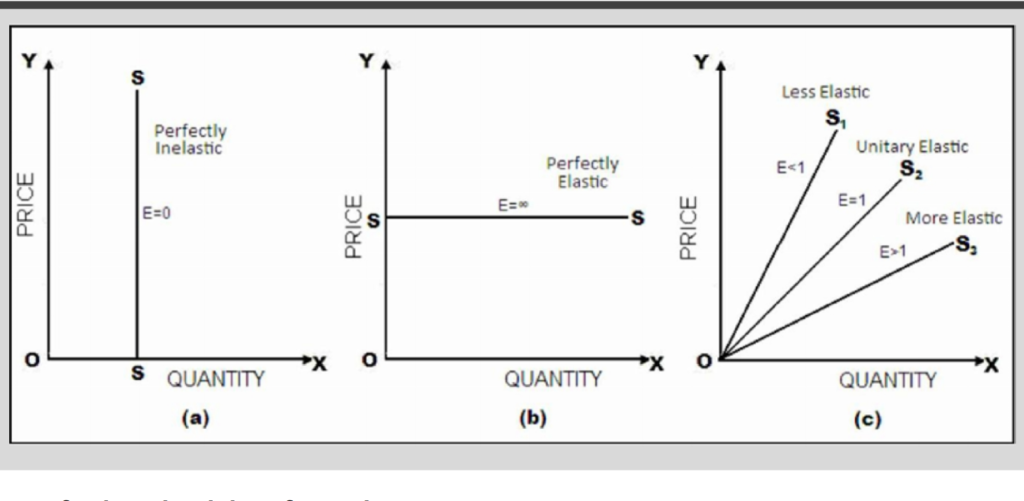Last updated on September 10th, 2022 at 02:35 am
Elasticity of supply is the magnitude of change in amount supplied in response to change in Price. The law of supply indicates the direction of change in quantity supplied in response to a change in price.
what is elasticity of supply?
Elasticity of supply is the relative measure of the degree of responsiveness of quantity supplied of a commodity to a change in its price. It is magnitude of change in amount supplied in response to change in Price.
Elasticity of supply
Law of supply does not express the magnitude of change in amount supplied in response to a change in price. This information is provided by the tool of elasticity of supply. Elasticity of supply is the relative measure of the degree of responsiveness of quantity supplied of a commodity to a change in its price.
The greater the responsiveness of quantity supplied of a commodity to the change in its price, the greater is its elasticity of supply.
Formula for Elasticity of Supply
To be more precise, It is defined as a percentage change in the quantity supplied of a product divided by the percentage change in price. It may be noted that the elasticity of supply has a positive sign because of the positive relationship between price and supply.
The formula for calculating price elasticity of supply is:
ES = Percentage Change in Quantity Supplied/Percentage Change in Price
Read More about Elasticity of Demand
Types of Elasticity of Supply
There are five types of price elasticity of supply depending upon the magnitude of response of supply to a change in price. The following are the Types
- Perfectly Elastic Supply
- Perfectly Inelastic Supply
- Relatively Elastic Supply
- Relatively Inelastic Supply
- Unitary Elastic Supply
Perfectly Elastic Supply: The supply is said to be perfectly elastic when a very insignificant change in price leads to an infinite change in quantity supplied. A very small rise in price causes supply to rise infinitely.
- Es = Infinity [ Perfectly Elastic Supply ]
Likewise a very insignificant fall in price reduces the supply to zero. The supply curve in such a situation is a horizontal line running parallel to x-axis. Numerically, elasticity of supply is said to be equal to infinity.
Perfectly Inelastic Supply: The supply is said to be perfectly inelastic when a change in price produces no change in the quantity supplied of a commodity.
- Es = 0 [ Perfectly Inelastic Supply ]
In such a case, quantity supplied remains constant regardless of change in price. The amount supplied is totally unresponsive to change in price. The supply curve in such a situation is a vertical line, parallel to y-axis. Numerically, elasticity of supply is said to be equal to zero.

Relatively Elastic Supply: The supply is relatively elastic when a small change in price causes a greater change in quantity supplied.
- Es> 1 [ Relatively Elastic Supply ]
In such a case a proportionate change in price of a commodity causes more than proportionate change in quantity supplied. For example, if price changes by 40% the quantity supplied of commodity changes by more than 40%. The supply curve in such a situation is relatively flatter. Numerically, elasticity of supply is said to be greater than 1.
Relatively Inelastic Supply: It is a situation where a greater change in price leads to smaller change in quantity supplied. The demand is said to be relatively inelastic when a proportionate change in price is greater than the proportionate change in quantity supplied.
- Es< 1 [ Relatively Inelastic Supply ]
For example, if price rises by 30%, quantity supplied rises by less than 30%. The supply curve in such a case is relatively steeper. Numerically, elasticity is said to be less than 1.
Unitary Elastic Supply: The supply is said to be unitary elastic when a change in price results in exactly the same percentage change in the quantity supplied of a commodity.
- Es = 1 [ Unitary Elastic Supply ]
In such a situation the percentage change in both the price and quantity supplied is the same. For example, if the price falls by 45%, the quantity supplied also falls by 45%. It is a straight line through the origin. Numerically, elasticity is said to be equal to 1.
Determinants of price elasticity of supply
Time Period: Time is the most significant factor which affects the elasticity. If the price of commodity rises and the producers have enough time to make adjustment in the level of output, the Supply elasticity will be more elastic. If the time period is short and the supply cannot be expanded after a price increase, the supply is relatively inelastic.
Ability to Store Output: The goods which can be safely stored have relatively elastic supply over the goods which are perishable and cannot be stored.
Factor Mobility: If the factors of production can be easily moved from one use to another, it will affect elasticity. The higher the mobility of factors, the greater is the elasticity of supply of the good and vice versa.
Cost Relationships: If costs rise rapidly as output is increased, then any increase in profitability caused by a rise in the price of the good is balanced by increased costs as supply increases. If this is so, supply will be relatively inelastic. On the other hand, if costs rise slowly as output increases, supply is likely to be relatively elastic.
